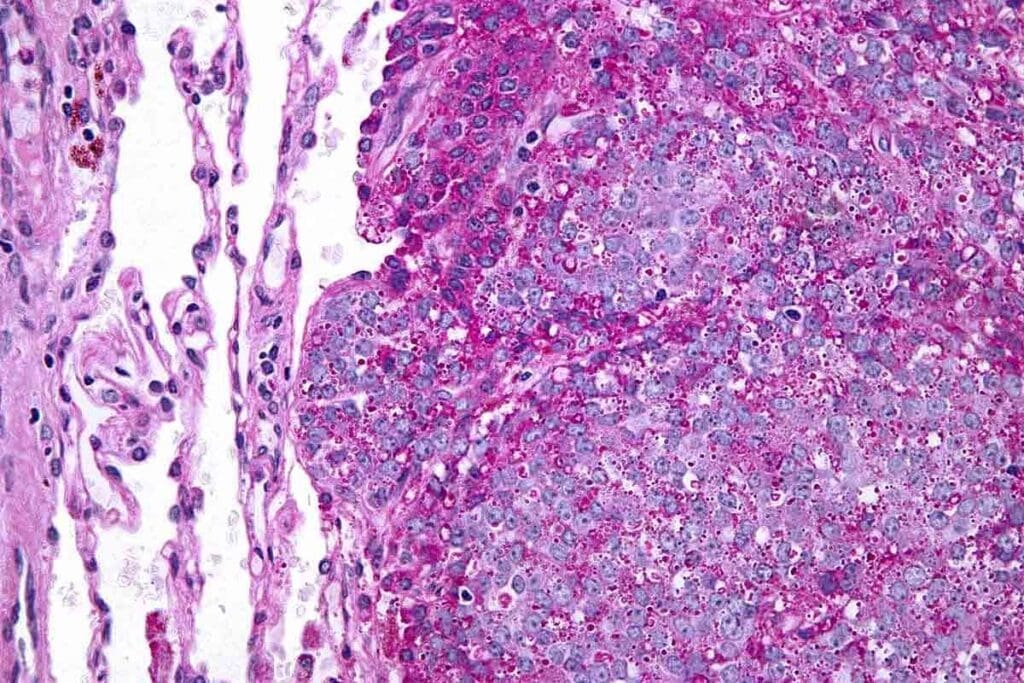Last Updated on November 20, 2025 by Ugurkan Demir

Ewing sarcoma is a serious tumor that requires a detailed and personalized treatment plan. New Ewing sarcoma treatments are bringing hope to patients facing this challenging diagnosis. At Liv Hospital, we put you at the center of every decision to ensure you receive the most advanced and effective care available.
Managing Ewing sarcoma involves a team-based approach that combines Ewing sarcoma treatments such as chemotherapy, surgery, and radiation therapy. Thanks to these advanced methods, survival rates have improved dramatically — from under 20% to over 70%. This progress reflects major advancements in both local treatments and stronger chemotherapy options.

Ewing sarcoma is a rare and aggressive cancer that mainly affects kids and young adults. It has a specific genetic change, t(11;22), which leads to the EWS-FLI1 fusion gene in most cases. This genetic change is key to Ewing sarcoma’s development.
The genetic basis of Ewing sarcoma involves a chromosomal translocation. This translocation, t(11;22), is seen in about 85% of cases. It combines the EWS gene on chromosome 22 with the FLI1 gene on chromosome 11. This creates the EWS-FLI1 fusion protein, a powerful transcription factor.
Ewing sarcoma is rare, making up about 1% of childhood cancers. It’s more common in males and usually appears in the second decade of life. It’s also more common in Caucasian populations than in others.
| Demographic Characteristics | Incidence Rates |
| Males | Higher incidence |
| Age Group | Typically 10-20 years |
| Caucasian Population | Higher incidence compared to other ethnic groups |
Diagnosing Ewing sarcoma involves imaging studies, biopsy, and genetic analysis. X-rays, CT scans, MRI, and PET scans help see the tumor’s size and location. A biopsy confirms the diagnosis through histological examination and genetic testing.
Staging is key for planning treatment and predicting outcomes. The staging system considers the tumor’s size, location, and if it has spread.

Advances in Ewing sarcoma treatment have changed how we fight this disease. Now, treating Ewing sarcoma is more complex. It involves a mix of treatments that have grown a lot over time.
In the past, Ewing sarcoma was seen as almost always fatal. This was because it was very aggressive and we didn’t know much about it. Back then, treatments mainly included radiation therapy and chemotherapy. Surgery was not a big part of the treatment.
Old treatments were based on:
Medical science has made big changes in treating Ewing sarcoma. Key improvements include:
Thanks to these advances, survival rates for Ewing sarcoma patients have gone up a lot. Research shows that:
As research keeps going, we expect even better treatments for Ewing sarcoma. New studies on targeted therapies and immunotherapy are very promising.
Managing Ewing sarcoma needs a team of experts. This team makes sure patients get the best care for their needs.
A team for Ewing sarcoma includes pediatric oncologists, orthopedic surgeons, radiation oncologists, radiologists, pathologists, and nurses who know about cancer. Each one is key in diagnosing, planning, and caring for the patient.
The pediatric oncologist leads the treatment plan, making sure the right chemotherapy is used. Orthopedic surgeons handle surgeries like biopsies and tumor removals. Radiation oncologists use radiation to kill cancer cells left behind.
Planning treatment together is vital for Ewing sarcoma. The team meets to create a plan that fits the patient’s needs. They consider the disease stage, the patient’s health, and more.
Team members meet often to keep the plan on track. They make changes as needed. This teamwork helps patients get better and avoids problems.
Putting the patient first is key in treating Ewing sarcoma. The team works with the patient and their family. They make sure treatment choices match the patient’s wishes and needs.
They talk about the pros and cons of treatments. They listen to concerns and offer support. This way, the team improves patient happiness and results.
Systemic chemotherapy is a key part of treating Ewing sarcoma. It helps fight both local and spread-out cancer. This approach is vital for better patient results.
For Ewing sarcoma, standard treatments mix different drugs. These treatments aim to quickly shrink tumors and fight hidden cancer cells.
Key components include vincristine, doxorubicin, and cyclophosphamide. Sometimes, etoposide and ifosfamide are added. The right mix depends on the patient’s age, tumor type, and doctor’s choice.
The drugs used in Ewing sarcoma treatment are very important. Cyclophosphamide and ifosfamide are key alkylating agents. Etoposide works by stopping topoisomerase II. Vincristine messes with microtubules, and doxorubicin stops DNA from growing in tumors.
Dose-intensified regimens aim to boost treatment effects. They use higher doses of drugs. The timing of when these drugs are given is also important.
Using granulocyte-colony stimulating factor (G-CSF) helps. It reduces the risk of low white blood cell counts and related issues.
Understanding systemic chemotherapy’s role in Ewing sarcoma treatment is key. This includes knowing the standard protocols, the drugs used, and how to intensify treatment. Healthcare providers can then create treatment plans that fit each patient’s needs.
Surgery is a key part of treating Ewing sarcoma. It helps control the disease and improve survival rates. Surgery is now a big part of treating this complex disease.
When to have surgery is a big decision. It depends on the tumor’s size, location, and how it responds to chemotherapy. Neoadjuvant chemotherapy is used first to shrink the tumor. This makes surgery easier and helps check how well the tumor responds to treatment.
In some cases, surgery is done right away if the tumor is easy to remove. But for many, surgery comes after chemotherapy. Sometimes, it’s done before or after radiation therapy.
Limb-sparing surgery is often chosen for tumors in the limbs. The goal is to remove the tumor without losing limb function or appearance. New surgical methods and prosthetics have made this surgery more successful.
Surgeons must weigh these factors when planning limb-sparing surgery. They often work with a team to get the best results.
After removing the tumor, reconstruction is needed to restore function and appearance. There are many options, including:
The choice of reconstruction depends on how much of the limb was removed, the patient’s health, and their wishes. A
“The reconstruction phase is as critical as the resection phase, requiring meticulous planning and execution to achieve optimal outcomes.”
– as noted by experts in orthopedic oncology.
Effective surgery, including limb-sparing and reconstruction, is key in controlling Ewing sarcoma. By combining surgery with other treatments, doctors can greatly improve patient outcomes.
Radiation therapy is key in treating Ewing sarcoma. It helps control the disease locally. It’s often used with chemotherapy and surgery for the best results.
Radiotherapy is used when tumors can’t be fully removed or when there’s a high risk of coming back. It can be given before surgery to make the tumor smaller. Or, it might be used after surgery to kill any cancer cells left behind. Sometimes, it’s the main treatment if surgery isn’t possible.
Doctors decide when to use radiotherapy based on many things. They look at the tumor’s size, location, and the patient’s health. A team of healthcare experts works together to choose the best time for radiotherapy.
New radiation methods have made treatments more precise and effective for Ewing sarcoma. Techniques like IMRT and proton therapy allow for high doses to the tumor. This helps protect healthy tissues nearby.
The radiation dose is carefully planned for each patient. The tumor’s size and location, along with the patient’s age and health, are important factors.
Radiation therapy is effective for Ewing sarcoma but can cause problems. Acute effects might include tiredness, skin reactions, and stomach issues. These depend on where the treatment is given.
Long-term issues can include second cancers, organ problems, and growth issues in kids. A detailed follow-up care plan is needed. This includes regular check-ups and treatments as required.
“The integration of radiation therapy into the treatment plan for Ewing sarcoma patients has been shown to improve local control and potentially enhance overall survival rates.” –
A renowned oncologist
Understanding radiation therapy’s role, timing, and management of side effects helps healthcare providers. This ensures the best treatment outcomes for Ewing sarcoma patients.
Maintenance therapy is key in treating Ewing sarcoma. It greatly lowers the chance of the cancer coming back. This is very important for those who have already had treatment.
Maintenance therapy aims to catch and kill cancer cells left after first treatments. Extended treatment regimens help increase survival chances and lower recurrence rates.
During the maintenance phase, a mix of drugs is used. These drugs are less strong than those in the first treatments but are vital for keeping the disease under control. Mercaptopurine and methotrexate are common drugs used in this phase.
The length of maintenance therapy varies based on how well the patient responds and the treatment plan. It’s important to keep a close eye on how the therapy is working. Monitoring protocols include blood tests, imaging, and doctor visits to manage side effects and check the treatment’s success.
Understanding the role of maintenance therapy is key. Following the treatment and monitoring plans helps patients with Ewing sarcoma live longer and better lives.
Treating metastatic Ewing sarcoma needs a detailed plan. This disease spreads to other parts of the body. So, it requires strong and specific treatments.
Whole lung irradiation (WLI) is key for lung metastases. It uses radiation to kill tiny cancer cells in the lungs. These cells might not show up on scans.
Intensified systemic therapy is vital for metastatic Ewing sarcoma. It uses strong chemotherapy to fight cancer cells that have spread.
This therapy can include:
Managing bone and distant metastases in Ewing sarcoma needs a team effort. This includes chemotherapy, radiation, and sometimes surgery.
Key Considerations:
By using these special methods, doctors can create detailed treatment plans. These plans meet the unique needs of patients with metastatic Ewing sarcoma.
New treatments like targeted molecular therapies and immunotherapy are giving hope to Ewing sarcoma patients. These treatments aim to improve outcomes and lessen side effects of traditional therapies.
These therapies target specific genetic or molecular issues in Ewing sarcoma. PARP inhibitors show promise for patients with certain genetic mutations. IGF-1R inhibitors are also being studied to block tumor development pathways.
| Targeted Therapy | Mechanism of Action | Current Status |
| PARP inhibitors | Inhibit DNA repair in cancer cells | Clinical trials |
| IGF-1R inhibitors | Block IGF-1R signaling pathway | Ongoing research |
Immunotherapy uses the immune system to fight cancer. CAR-T cell therapy and checkpoint inhibitors are being studied for Ewing sarcoma treatment.
For patients with relapsed or refractory Ewing sarcoma, effective management is key. This includes intensified chemotherapy, targeted therapies, and innovative treatments like high-dose chemotherapy followed by stem cell transplantation.
The future of Ewing sarcoma treatment is bright with ongoing research and new therapies. This offers hope for better outcomes and quality of life for patients.
Ewing sarcoma treatment has grown a lot. A team of doctors working together is key for the best results. Using different treatments like chemotherapy, surgery, and radiation is important.
This mix helps patients live longer and feel better. Adding new treatments like targeted therapies and immunotherapy makes things even better for patients.
Each patient needs a treatment plan that fits them. This way, doctors can get the best results and reduce side effects. As new treatments come along, they will keep making things better for Ewing sarcoma patients.
A team of doctors working together is very important. They make sure patients get all the care they need. This leads to the best possible results for patients.
Ewing sarcoma is a rare cancer that mainly affects kids and young adults. Doctors use X-rays, CT scans, and MRI scans to find it. Then, a biopsy confirms if it’s cancer.
Ewing sarcoma treatment often includes chemotherapy, surgery, and radiation. The plan depends on the tumor’s size, location, and the patient’s needs.
Chemotherapy is key in treating Ewing sarcoma. It aims to kill cancer cells that have spread. Common treatments include cyclophosphamide, ifosfamide, etoposide, vincristine, and doxorubicin.
Radiation therapy helps control local disease. It can be used with surgery or alone. Modern techniques like IMRT target the tumor precisely, reducing harm to nearby tissues.
For metastatic Ewing sarcoma, treatments include whole lung irradiation and intensified chemotherapy. The goal is to manage the disease spread and improve outcomes.
New treatments include targeted therapies and immunotherapy. These aim to better outcomes and offer hope for patients with resistant or recurrent disease.
Maintenance therapy helps prevent recurrence. It involves ongoing treatment with specific medications. The length and monitoring depend on the patient’s needs.
A team of specialists is vital in treating Ewing sarcoma. They include oncologists, surgeons, and radiation therapists. This team ensures patients get the best care.
Ewing sarcoma treatment has greatly improved. Advances in chemotherapy, surgery, and radiation have led to better survival rates and outcomes.
Outcomes depend on the tumor’s stage, location, and patient demographics. A detailed and team-based approach is key to improving results.
Subscribe to our e-newsletter to stay informed about the latest innovations in the world of health and exclusive offers!